Auditing and Assurance Case Study: Opinion and Reporting (ACC302)
VerifiedAdded on 2022/08/25
|7
|1447
|15
Case Study
AI Summary
This case study examines various scenarios in auditing and assurance, focusing on the application of different audit opinions based on specific situations. The analysis covers three key areas: the issuance of an adverse opinion due to the inappropriate use of the last-in, first-out (LIFO) method for inventory valuation by Beast Ltd, which leads to material and pervasive misstatements; the determination of a qualified opinion for SecondBite Foundation, a non-for-profit entity, due to the lack of robust internal controls over income, although the income has been correctly accounted for; and the application of a qualified opinion for Golddiggers Pty Ltd, where uncertainties regarding the company's going concern status arise due to the expiry of a vein and the lack of a land supervisor's report; and finally, the issuance of a disclaimer of opinion for Main Insurance due to the finance director's refusal to disclose related party information as per AASB 124. The analysis refers to relevant Australian Accounting Standards (AASB) and provides detailed explanations for each audit opinion, including the rationale and implications.
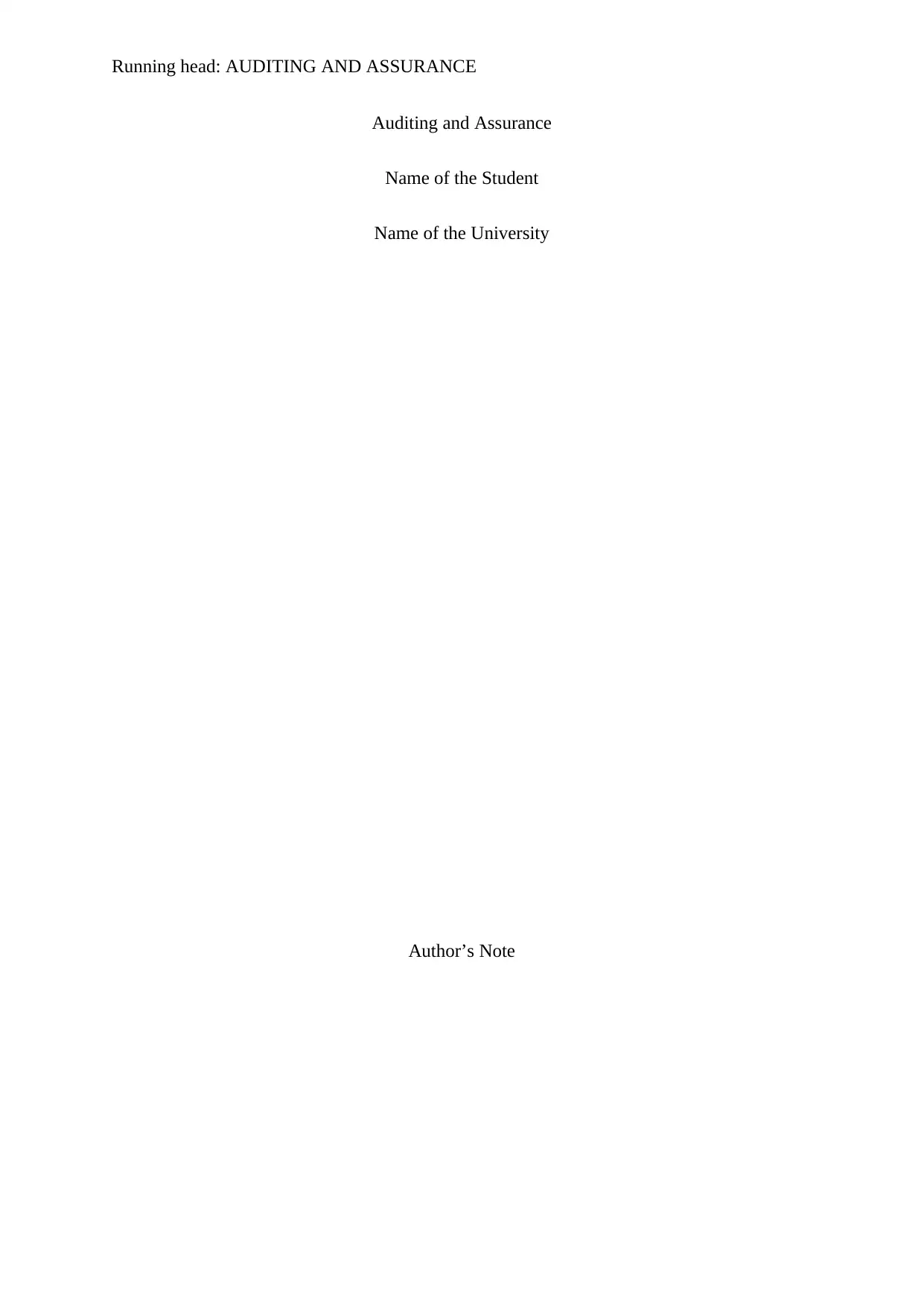
Running head: AUDITING AND ASSURANCE
Auditing and Assurance
Name of the Student
Name of the University
Author’s Note
Auditing and Assurance
Name of the Student
Name of the University
Author’s Note
Paraphrase This Document
Need a fresh take? Get an instant paraphrase of this document with our AI Paraphraser
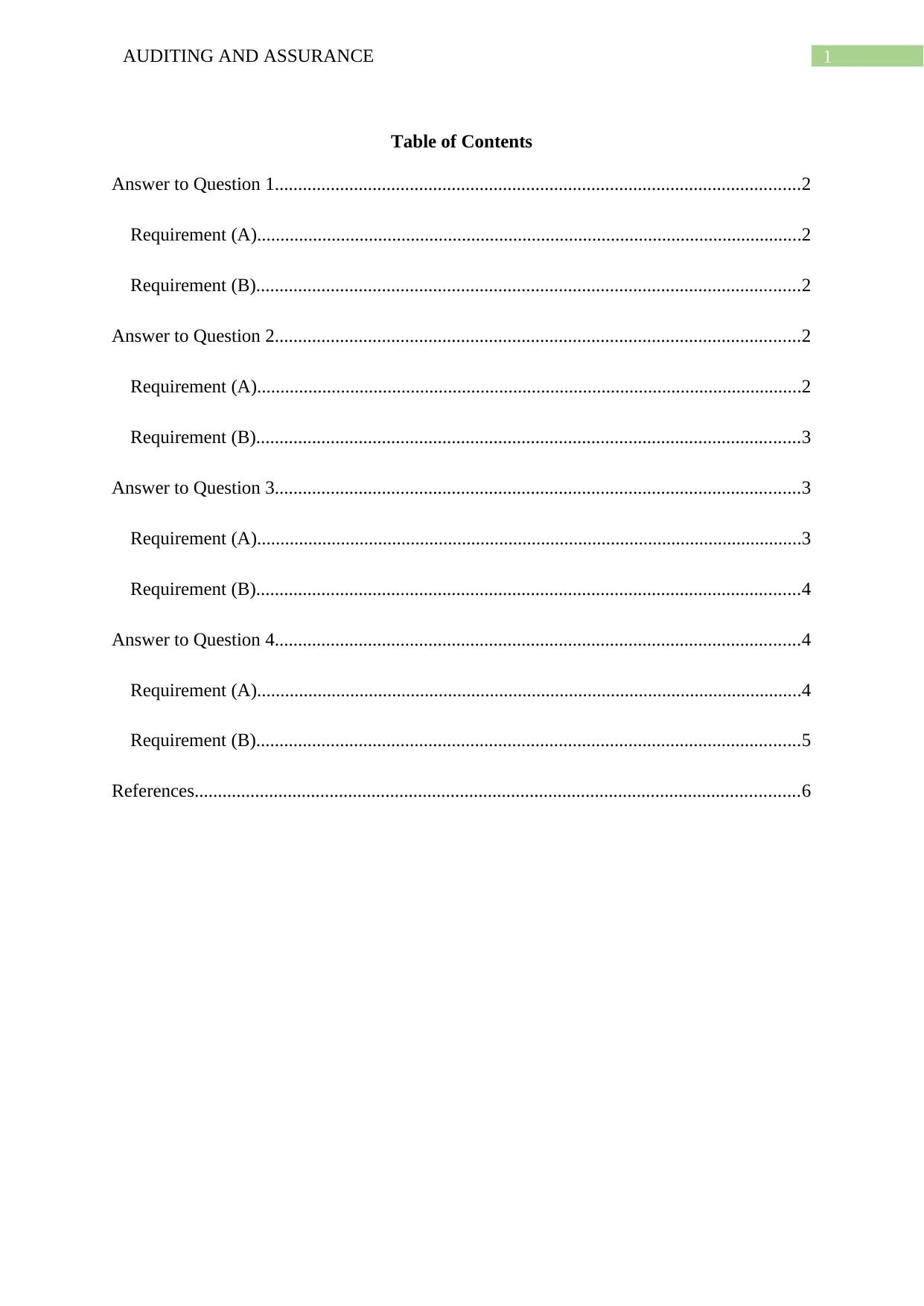
1AUDITING AND ASSURANCE
Table of Contents
Answer to Question 1.................................................................................................................2
Requirement (A).....................................................................................................................2
Requirement (B).....................................................................................................................2
Answer to Question 2.................................................................................................................2
Requirement (A).....................................................................................................................2
Requirement (B).....................................................................................................................3
Answer to Question 3.................................................................................................................3
Requirement (A).....................................................................................................................3
Requirement (B).....................................................................................................................4
Answer to Question 4.................................................................................................................4
Requirement (A).....................................................................................................................4
Requirement (B).....................................................................................................................5
References..................................................................................................................................6
Table of Contents
Answer to Question 1.................................................................................................................2
Requirement (A).....................................................................................................................2
Requirement (B).....................................................................................................................2
Answer to Question 2.................................................................................................................2
Requirement (A).....................................................................................................................2
Requirement (B).....................................................................................................................3
Answer to Question 3.................................................................................................................3
Requirement (A).....................................................................................................................3
Requirement (B).....................................................................................................................4
Answer to Question 4.................................................................................................................4
Requirement (A).....................................................................................................................4
Requirement (B).....................................................................................................................5
References..................................................................................................................................6
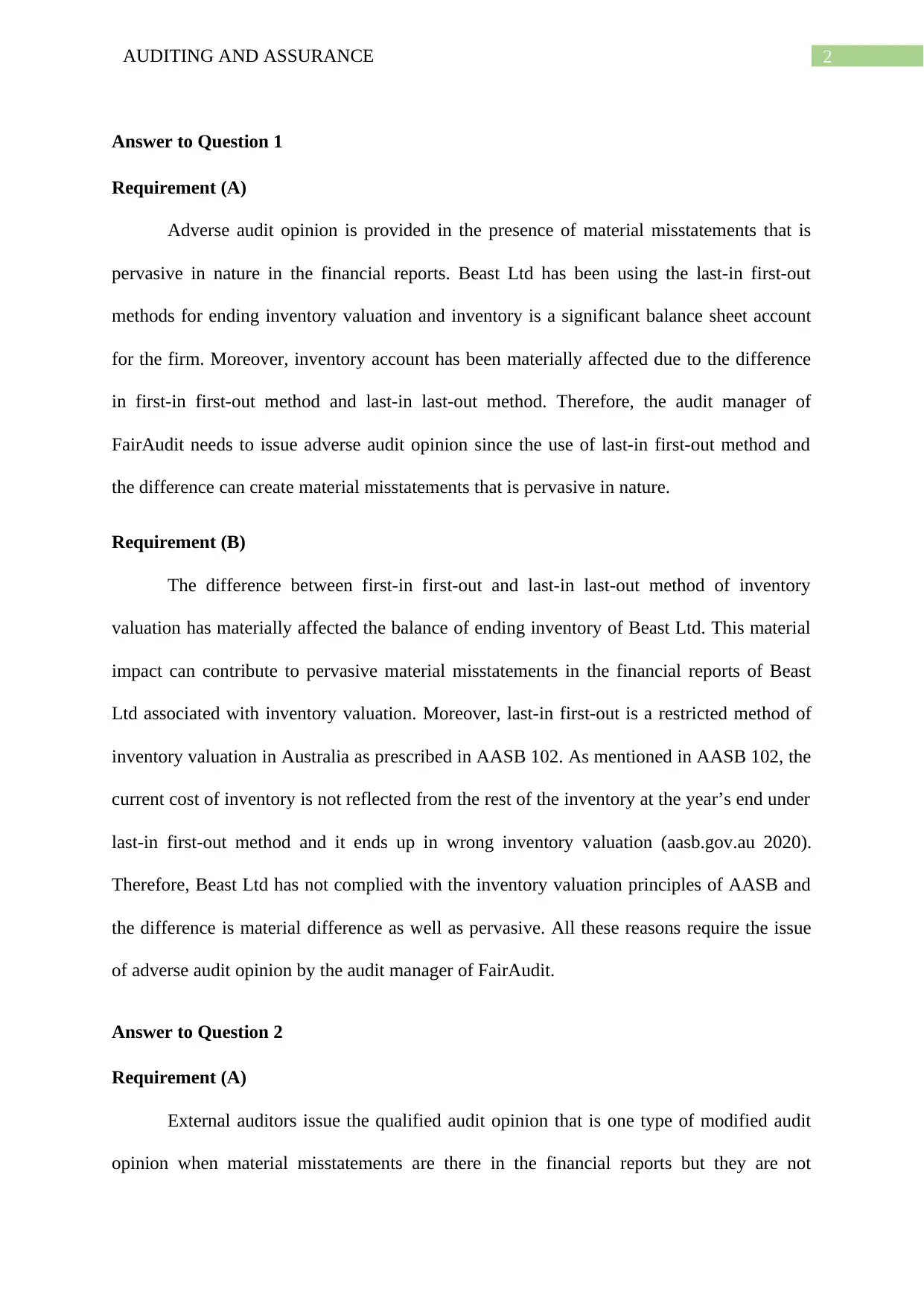
2AUDITING AND ASSURANCE
Answer to Question 1
Requirement (A)
Adverse audit opinion is provided in the presence of material misstatements that is
pervasive in nature in the financial reports. Beast Ltd has been using the last-in first-out
methods for ending inventory valuation and inventory is a significant balance sheet account
for the firm. Moreover, inventory account has been materially affected due to the difference
in first-in first-out method and last-in last-out method. Therefore, the audit manager of
FairAudit needs to issue adverse audit opinion since the use of last-in first-out method and
the difference can create material misstatements that is pervasive in nature.
Requirement (B)
The difference between first-in first-out and last-in last-out method of inventory
valuation has materially affected the balance of ending inventory of Beast Ltd. This material
impact can contribute to pervasive material misstatements in the financial reports of Beast
Ltd associated with inventory valuation. Moreover, last-in first-out is a restricted method of
inventory valuation in Australia as prescribed in AASB 102. As mentioned in AASB 102, the
current cost of inventory is not reflected from the rest of the inventory at the year’s end under
last-in first-out method and it ends up in wrong inventory valuation (aasb.gov.au 2020).
Therefore, Beast Ltd has not complied with the inventory valuation principles of AASB and
the difference is material difference as well as pervasive. All these reasons require the issue
of adverse audit opinion by the audit manager of FairAudit.
Answer to Question 2
Requirement (A)
External auditors issue the qualified audit opinion that is one type of modified audit
opinion when material misstatements are there in the financial reports but they are not
Answer to Question 1
Requirement (A)
Adverse audit opinion is provided in the presence of material misstatements that is
pervasive in nature in the financial reports. Beast Ltd has been using the last-in first-out
methods for ending inventory valuation and inventory is a significant balance sheet account
for the firm. Moreover, inventory account has been materially affected due to the difference
in first-in first-out method and last-in last-out method. Therefore, the audit manager of
FairAudit needs to issue adverse audit opinion since the use of last-in first-out method and
the difference can create material misstatements that is pervasive in nature.
Requirement (B)
The difference between first-in first-out and last-in last-out method of inventory
valuation has materially affected the balance of ending inventory of Beast Ltd. This material
impact can contribute to pervasive material misstatements in the financial reports of Beast
Ltd associated with inventory valuation. Moreover, last-in first-out is a restricted method of
inventory valuation in Australia as prescribed in AASB 102. As mentioned in AASB 102, the
current cost of inventory is not reflected from the rest of the inventory at the year’s end under
last-in first-out method and it ends up in wrong inventory valuation (aasb.gov.au 2020).
Therefore, Beast Ltd has not complied with the inventory valuation principles of AASB and
the difference is material difference as well as pervasive. All these reasons require the issue
of adverse audit opinion by the audit manager of FairAudit.
Answer to Question 2
Requirement (A)
External auditors issue the qualified audit opinion that is one type of modified audit
opinion when material misstatements are there in the financial reports but they are not
⊘ This is a preview!⊘
Do you want full access?
Subscribe today to unlock all pages.

Trusted by 1+ million students worldwide

3AUDITING AND ASSURANCE
pervasive material misstatements which that auditors need to conclude through audit testing
(George-Silviu and Melinda-Timea 2015). SecondBite Foundation, a non-for-profit firm and
non-reporting entity, does not have proper internal control in place for income and this makes
the audit manager of FairAudit to assess whether all the income received has been recorded,
but the company has correctly accounted for the income. This whole situation requires the
audit manager to give qualified audit opinion to the firm.
Requirement (B)
A non-for-profit firm needs to immediately recognize income for the additional of the
initial carrying value of an asset over the related recognized amount as prescribed in AASB
1058, Para 10 (aasb.gov.au 2020). This has correctly followed by SecondBite Foundation for
the accounting of income even though adequate internal control for income recognition was
absent. Therefore, this indicates towards the presence of material misstatements in income
that is not pervasive. Moreover, SecondBite Foundation is a non-reporting entity and it means
it does not have any external users dependent on its financial statements in order to make and
evaluate decisions about its scarce resources. In the presence of these reasons, qualified audit
opinion is required to be issued by the audit manager of FairAudit. Moreover, the audit
manager is also responsible for adding an additional paragraph in the audit report of
SecondBite Foundation by declaring these reasons for issuing qualified audit opinion.
Answer to Question 3
Requirement (A)
An audit report needs to be considered as a qualified audit report when certain matter
is emphasized by the external auditor as it creates material influence on the financial reports.
Audit report is considered as qualified audit report in the presence of key concerns on the
going concern status of the audit client (Salawu, Moromoke Oladejo and Godwin 2017). One
pervasive material misstatements which that auditors need to conclude through audit testing
(George-Silviu and Melinda-Timea 2015). SecondBite Foundation, a non-for-profit firm and
non-reporting entity, does not have proper internal control in place for income and this makes
the audit manager of FairAudit to assess whether all the income received has been recorded,
but the company has correctly accounted for the income. This whole situation requires the
audit manager to give qualified audit opinion to the firm.
Requirement (B)
A non-for-profit firm needs to immediately recognize income for the additional of the
initial carrying value of an asset over the related recognized amount as prescribed in AASB
1058, Para 10 (aasb.gov.au 2020). This has correctly followed by SecondBite Foundation for
the accounting of income even though adequate internal control for income recognition was
absent. Therefore, this indicates towards the presence of material misstatements in income
that is not pervasive. Moreover, SecondBite Foundation is a non-reporting entity and it means
it does not have any external users dependent on its financial statements in order to make and
evaluate decisions about its scarce resources. In the presence of these reasons, qualified audit
opinion is required to be issued by the audit manager of FairAudit. Moreover, the audit
manager is also responsible for adding an additional paragraph in the audit report of
SecondBite Foundation by declaring these reasons for issuing qualified audit opinion.
Answer to Question 3
Requirement (A)
An audit report needs to be considered as a qualified audit report when certain matter
is emphasized by the external auditor as it creates material influence on the financial reports.
Audit report is considered as qualified audit report in the presence of key concerns on the
going concern status of the audit client (Salawu, Moromoke Oladejo and Godwin 2017). One
Paraphrase This Document
Need a fresh take? Get an instant paraphrase of this document with our AI Paraphraser
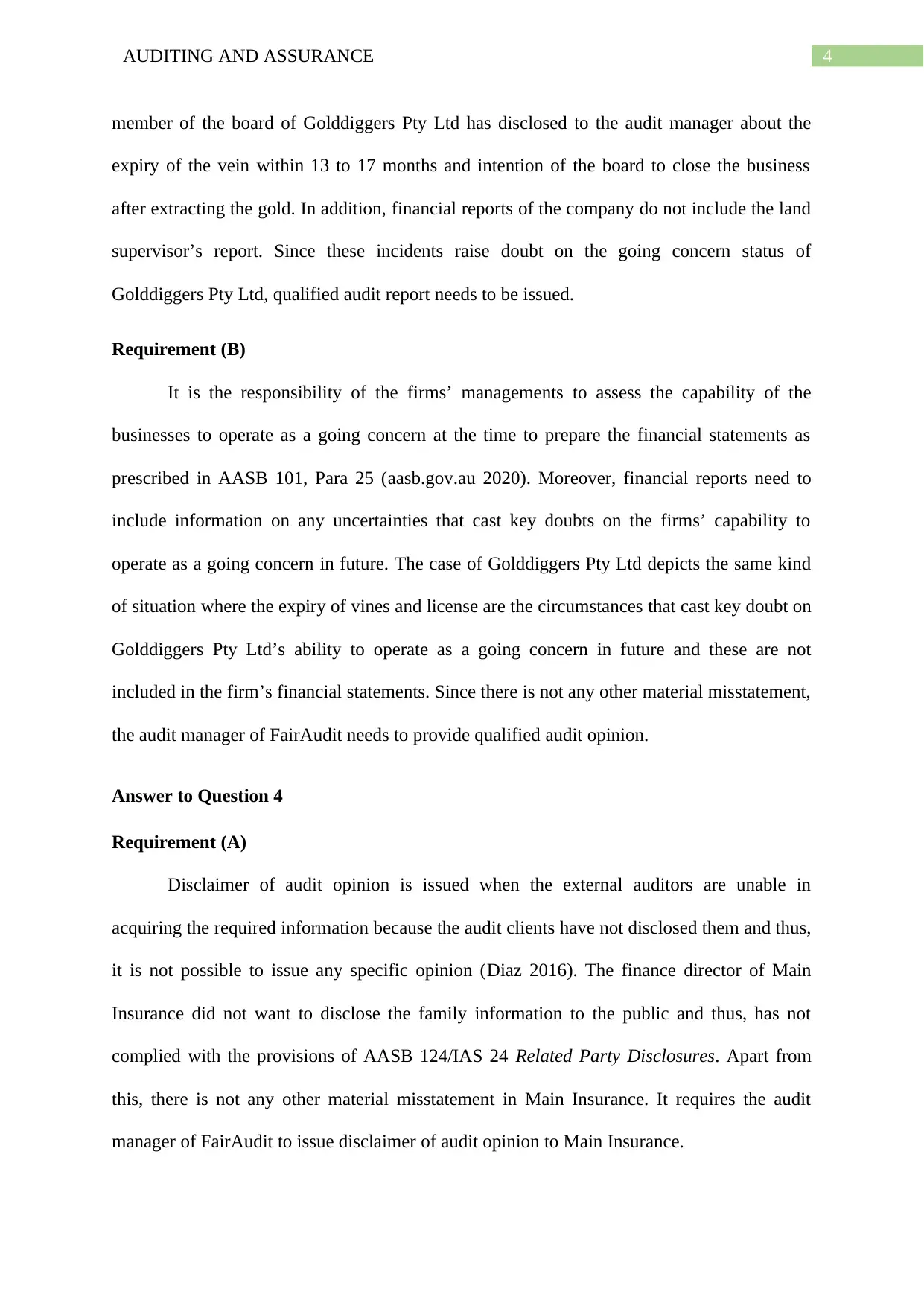
4AUDITING AND ASSURANCE
member of the board of Golddiggers Pty Ltd has disclosed to the audit manager about the
expiry of the vein within 13 to 17 months and intention of the board to close the business
after extracting the gold. In addition, financial reports of the company do not include the land
supervisor’s report. Since these incidents raise doubt on the going concern status of
Golddiggers Pty Ltd, qualified audit report needs to be issued.
Requirement (B)
It is the responsibility of the firms’ managements to assess the capability of the
businesses to operate as a going concern at the time to prepare the financial statements as
prescribed in AASB 101, Para 25 (aasb.gov.au 2020). Moreover, financial reports need to
include information on any uncertainties that cast key doubts on the firms’ capability to
operate as a going concern in future. The case of Golddiggers Pty Ltd depicts the same kind
of situation where the expiry of vines and license are the circumstances that cast key doubt on
Golddiggers Pty Ltd’s ability to operate as a going concern in future and these are not
included in the firm’s financial statements. Since there is not any other material misstatement,
the audit manager of FairAudit needs to provide qualified audit opinion.
Answer to Question 4
Requirement (A)
Disclaimer of audit opinion is issued when the external auditors are unable in
acquiring the required information because the audit clients have not disclosed them and thus,
it is not possible to issue any specific opinion (Diaz 2016). The finance director of Main
Insurance did not want to disclose the family information to the public and thus, has not
complied with the provisions of AASB 124/IAS 24 Related Party Disclosures. Apart from
this, there is not any other material misstatement in Main Insurance. It requires the audit
manager of FairAudit to issue disclaimer of audit opinion to Main Insurance.
member of the board of Golddiggers Pty Ltd has disclosed to the audit manager about the
expiry of the vein within 13 to 17 months and intention of the board to close the business
after extracting the gold. In addition, financial reports of the company do not include the land
supervisor’s report. Since these incidents raise doubt on the going concern status of
Golddiggers Pty Ltd, qualified audit report needs to be issued.
Requirement (B)
It is the responsibility of the firms’ managements to assess the capability of the
businesses to operate as a going concern at the time to prepare the financial statements as
prescribed in AASB 101, Para 25 (aasb.gov.au 2020). Moreover, financial reports need to
include information on any uncertainties that cast key doubts on the firms’ capability to
operate as a going concern in future. The case of Golddiggers Pty Ltd depicts the same kind
of situation where the expiry of vines and license are the circumstances that cast key doubt on
Golddiggers Pty Ltd’s ability to operate as a going concern in future and these are not
included in the firm’s financial statements. Since there is not any other material misstatement,
the audit manager of FairAudit needs to provide qualified audit opinion.
Answer to Question 4
Requirement (A)
Disclaimer of audit opinion is issued when the external auditors are unable in
acquiring the required information because the audit clients have not disclosed them and thus,
it is not possible to issue any specific opinion (Diaz 2016). The finance director of Main
Insurance did not want to disclose the family information to the public and thus, has not
complied with the provisions of AASB 124/IAS 24 Related Party Disclosures. Apart from
this, there is not any other material misstatement in Main Insurance. It requires the audit
manager of FairAudit to issue disclaimer of audit opinion to Main Insurance.
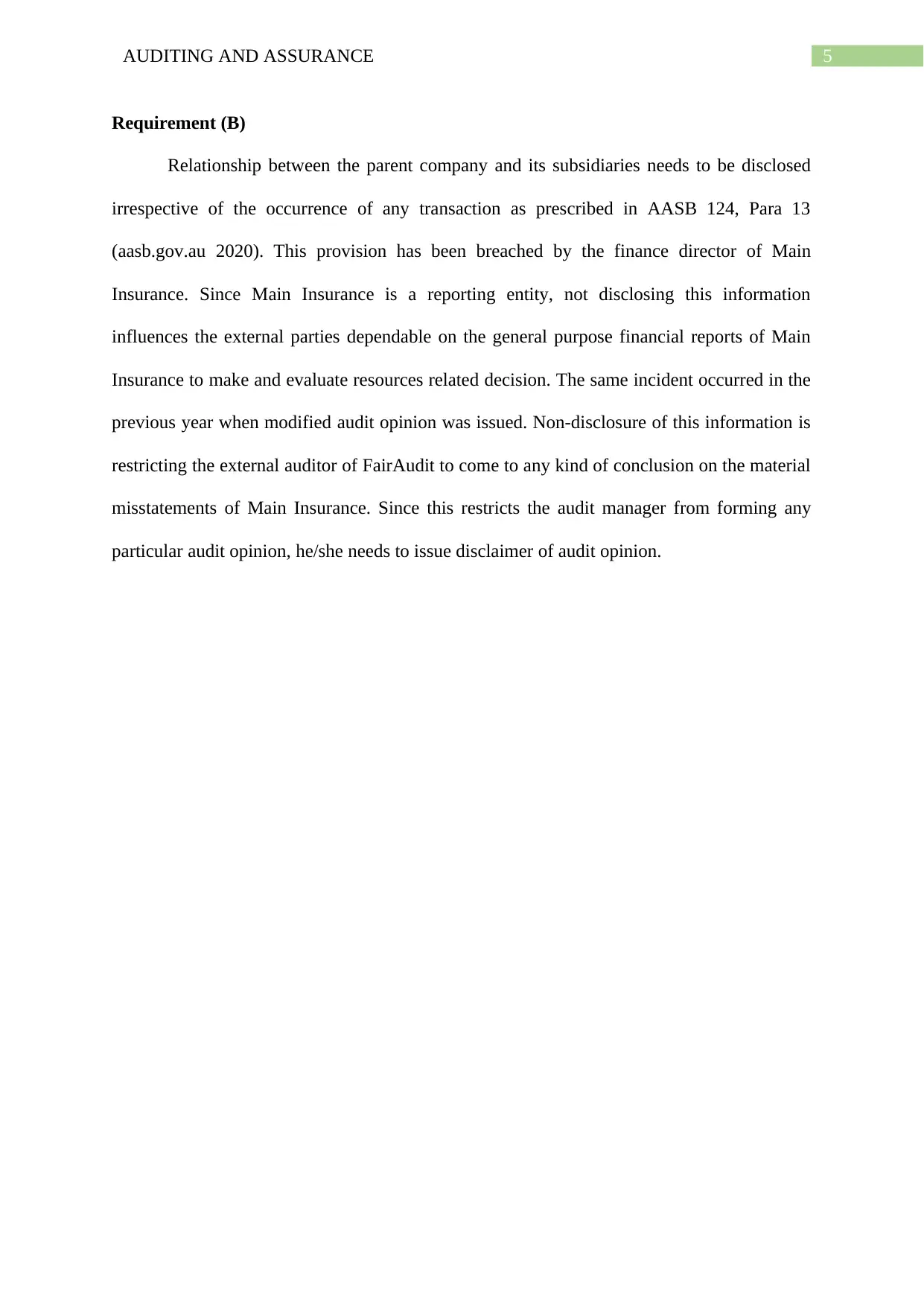
5AUDITING AND ASSURANCE
Requirement (B)
Relationship between the parent company and its subsidiaries needs to be disclosed
irrespective of the occurrence of any transaction as prescribed in AASB 124, Para 13
(aasb.gov.au 2020). This provision has been breached by the finance director of Main
Insurance. Since Main Insurance is a reporting entity, not disclosing this information
influences the external parties dependable on the general purpose financial reports of Main
Insurance to make and evaluate resources related decision. The same incident occurred in the
previous year when modified audit opinion was issued. Non-disclosure of this information is
restricting the external auditor of FairAudit to come to any kind of conclusion on the material
misstatements of Main Insurance. Since this restricts the audit manager from forming any
particular audit opinion, he/she needs to issue disclaimer of audit opinion.
Requirement (B)
Relationship between the parent company and its subsidiaries needs to be disclosed
irrespective of the occurrence of any transaction as prescribed in AASB 124, Para 13
(aasb.gov.au 2020). This provision has been breached by the finance director of Main
Insurance. Since Main Insurance is a reporting entity, not disclosing this information
influences the external parties dependable on the general purpose financial reports of Main
Insurance to make and evaluate resources related decision. The same incident occurred in the
previous year when modified audit opinion was issued. Non-disclosure of this information is
restricting the external auditor of FairAudit to come to any kind of conclusion on the material
misstatements of Main Insurance. Since this restricts the audit manager from forming any
particular audit opinion, he/she needs to issue disclaimer of audit opinion.
⊘ This is a preview!⊘
Do you want full access?
Subscribe today to unlock all pages.

Trusted by 1+ million students worldwide
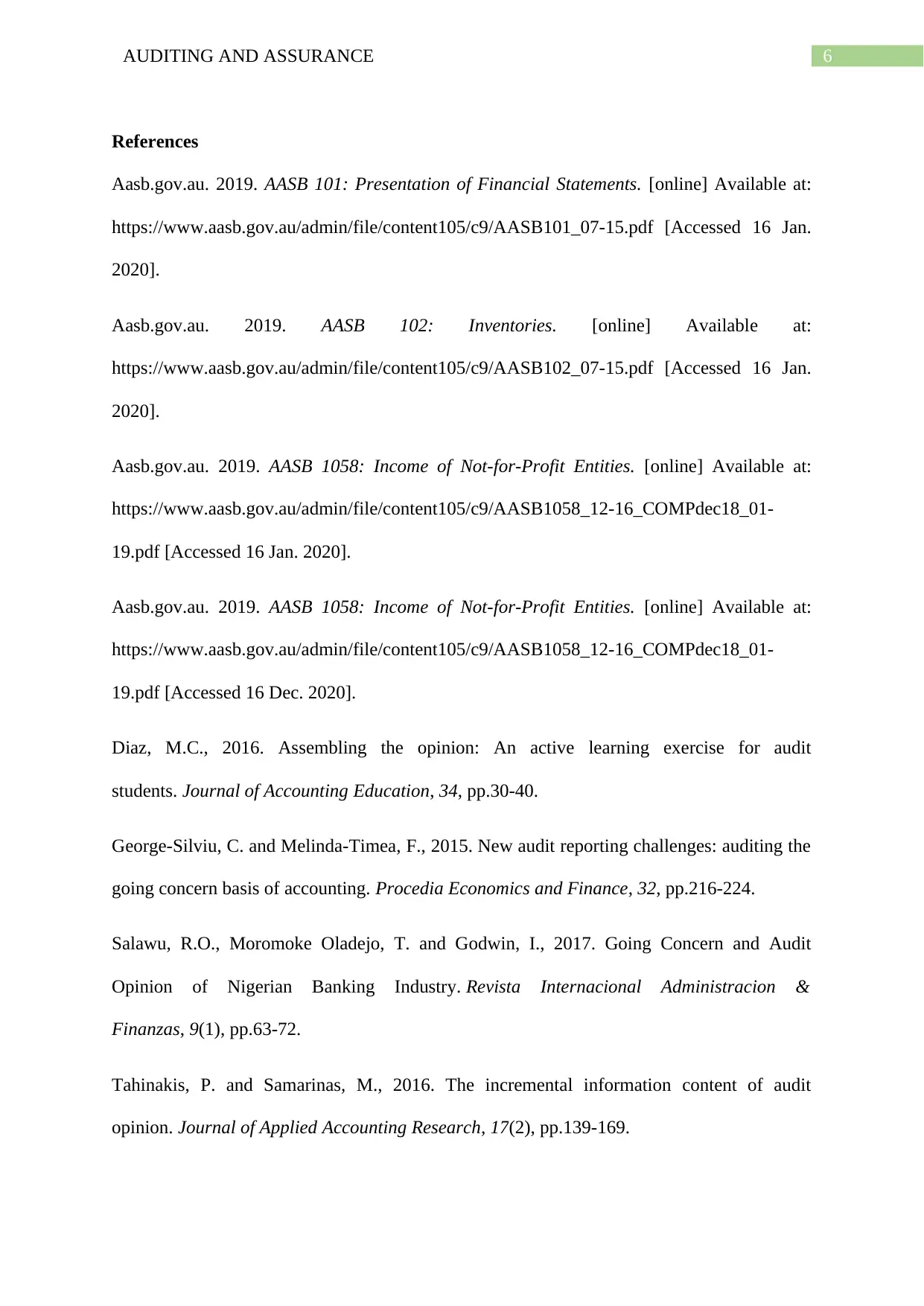
6AUDITING AND ASSURANCE
References
Aasb.gov.au. 2019. AASB 101: Presentation of Financial Statements. [online] Available at:
https://www.aasb.gov.au/admin/file/content105/c9/AASB101_07-15.pdf [Accessed 16 Jan.
2020].
Aasb.gov.au. 2019. AASB 102: Inventories. [online] Available at:
https://www.aasb.gov.au/admin/file/content105/c9/AASB102_07-15.pdf [Accessed 16 Jan.
2020].
Aasb.gov.au. 2019. AASB 1058: Income of Not-for-Profit Entities. [online] Available at:
https://www.aasb.gov.au/admin/file/content105/c9/AASB1058_12-16_COMPdec18_01-
19.pdf [Accessed 16 Jan. 2020].
Aasb.gov.au. 2019. AASB 1058: Income of Not-for-Profit Entities. [online] Available at:
https://www.aasb.gov.au/admin/file/content105/c9/AASB1058_12-16_COMPdec18_01-
19.pdf [Accessed 16 Dec. 2020].
Diaz, M.C., 2016. Assembling the opinion: An active learning exercise for audit
students. Journal of Accounting Education, 34, pp.30-40.
George-Silviu, C. and Melinda-Timea, F., 2015. New audit reporting challenges: auditing the
going concern basis of accounting. Procedia Economics and Finance, 32, pp.216-224.
Salawu, R.O., Moromoke Oladejo, T. and Godwin, I., 2017. Going Concern and Audit
Opinion of Nigerian Banking Industry. Revista Internacional Administracion &
Finanzas, 9(1), pp.63-72.
Tahinakis, P. and Samarinas, M., 2016. The incremental information content of audit
opinion. Journal of Applied Accounting Research, 17(2), pp.139-169.
References
Aasb.gov.au. 2019. AASB 101: Presentation of Financial Statements. [online] Available at:
https://www.aasb.gov.au/admin/file/content105/c9/AASB101_07-15.pdf [Accessed 16 Jan.
2020].
Aasb.gov.au. 2019. AASB 102: Inventories. [online] Available at:
https://www.aasb.gov.au/admin/file/content105/c9/AASB102_07-15.pdf [Accessed 16 Jan.
2020].
Aasb.gov.au. 2019. AASB 1058: Income of Not-for-Profit Entities. [online] Available at:
https://www.aasb.gov.au/admin/file/content105/c9/AASB1058_12-16_COMPdec18_01-
19.pdf [Accessed 16 Jan. 2020].
Aasb.gov.au. 2019. AASB 1058: Income of Not-for-Profit Entities. [online] Available at:
https://www.aasb.gov.au/admin/file/content105/c9/AASB1058_12-16_COMPdec18_01-
19.pdf [Accessed 16 Dec. 2020].
Diaz, M.C., 2016. Assembling the opinion: An active learning exercise for audit
students. Journal of Accounting Education, 34, pp.30-40.
George-Silviu, C. and Melinda-Timea, F., 2015. New audit reporting challenges: auditing the
going concern basis of accounting. Procedia Economics and Finance, 32, pp.216-224.
Salawu, R.O., Moromoke Oladejo, T. and Godwin, I., 2017. Going Concern and Audit
Opinion of Nigerian Banking Industry. Revista Internacional Administracion &
Finanzas, 9(1), pp.63-72.
Tahinakis, P. and Samarinas, M., 2016. The incremental information content of audit
opinion. Journal of Applied Accounting Research, 17(2), pp.139-169.
1 out of 7
Related Documents
Your All-in-One AI-Powered Toolkit for Academic Success.
+13062052269
info@desklib.com
Available 24*7 on WhatsApp / Email
![[object Object]](/_next/static/media/star-bottom.7253800d.svg)
Unlock your academic potential
Copyright © 2020–2025 A2Z Services. All Rights Reserved. Developed and managed by ZUCOL.





